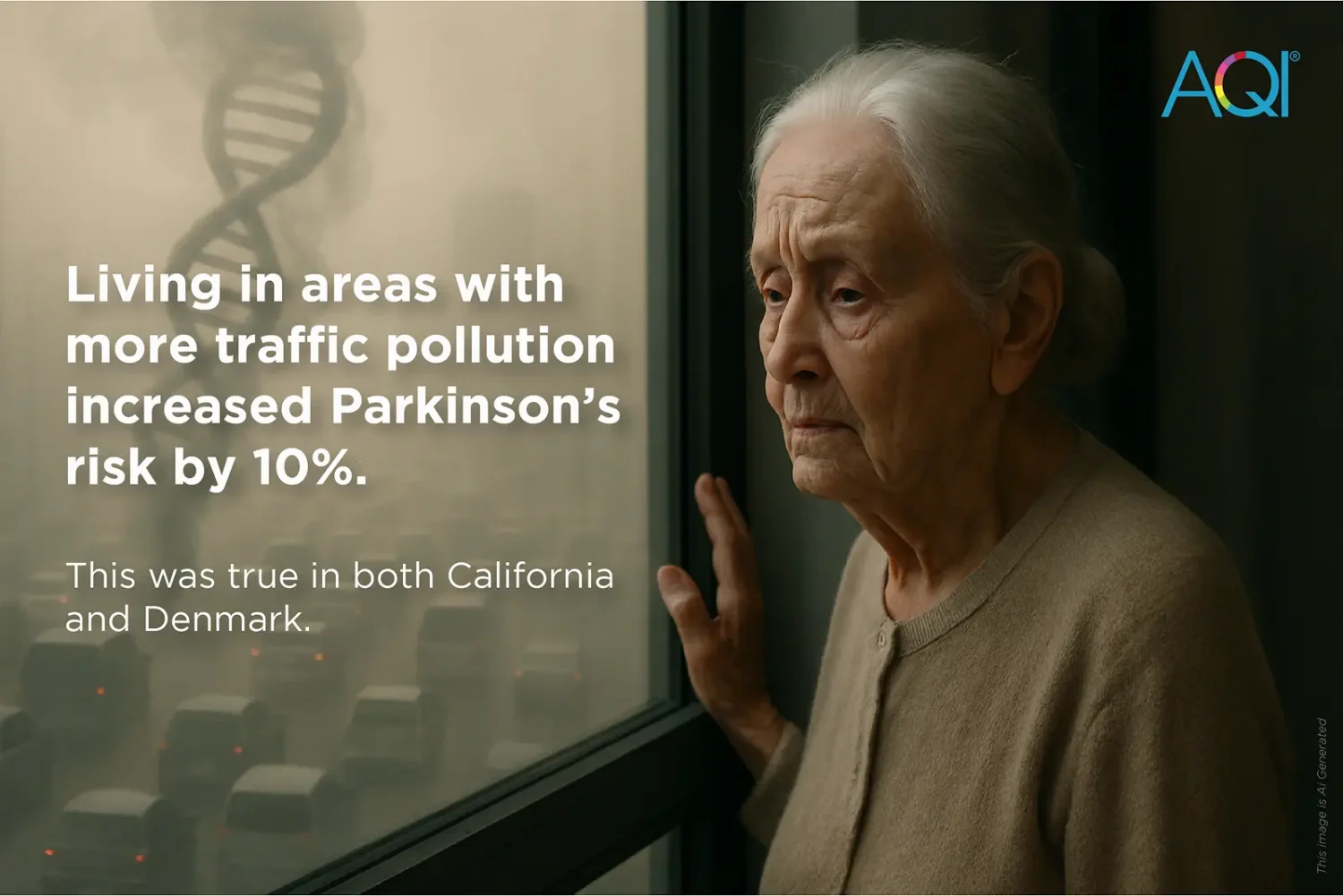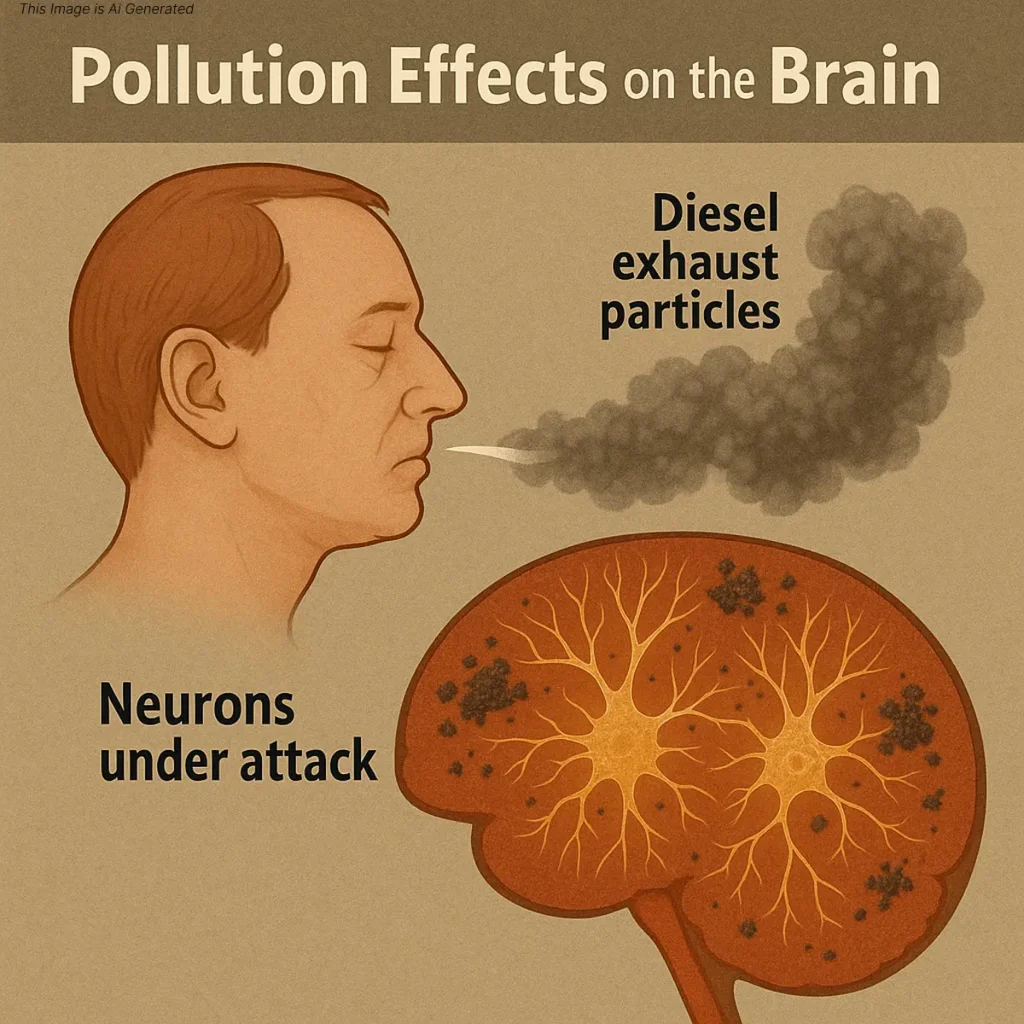You have noticed your grandparents’ hands tremble as they try to hold a coffee mug, or your neighbour, barely 60, moves more slowly than usual, struggling with stiffness. These could be signs of Parkinson’s disease, a condition that affects how the brain controls movement. It’s tough to watch, and even tougher to live with. But what if something as common as the air we breathe—polluted by car exhaust—could be increasing the risk of Parkinson’s? A new study has uncovered a startling connection between air pollution and Parkinson’s Disease, especially for people with certain genes. Let’s start with the basic information about the PD and how the study has helped in the findings.
What’s Parkinson’s Disease?
Do you know your brain is a control centre for your body’s movements? Parkinson’s happens when the brain starts losing cells that produce dopamine, a chemical that helps you move smoothly. This leads to symptoms like shaky hands, stiff muscles, slow steps, and trouble balancing. For reference, it is like the normal wiring in the brain gets frayed, making everyday easy tasks harder. While Parkinson’s often shows up in older adults, it’s not just about ageing. Genetics play a role, but the environment—like the air around us—might be a bigger factor than we thought.
The Study: Digging into Air Pollution and Parkinson’s Disease
A group of researchers, including Dayoon Kwon and Beate Ritz, published a study in ’s turning heads. They wanted to know if traffic-related (think car exhaust fumes) could team up with genetic risks to make Parkinson’s more likely. They looked at two groups of people—one from central California (the PEG study) and one from Denmark (the PASIDA study). Together, they studied 1,600 people with Parkinson’s and 1,778 healthy folks to compare their experiences.

Who Was Involved?
- California (PEG): This group had 634 people with Parkinson’s and 733 without, with an average age of about 67. They were a diverse bunch—71% White, 19% Latino, 5% American Indian or Alaska Native, 3% Asian, and 2% African American. Think of a mix like your local community, with farmers, teachers, and retirees.
- Denmark (PASIDA): This group included 966 Parkinson’s patients and 1,045 healthy people, averaging 63 years old. Most were of European background, like many families in small Danish towns.
- The Big Picture: About 62% of the Parkinson’s patients were men, and 56% of the healthy group were men, which fits since Parkinson’s tends to affect men a bit more.
How Did They Measure Air Pollution to Understand Parkinson’s Disease?
The researchers focused on traffic-related air pollution, or TRAP, which comes from car and truck exhaust. They used carbon monoxide (CO) levels to represent this pollution, as it’s a key marker of vehicle fumes. They figured out how many people were exposed at their homes over many years:
- In California, they used a model to estimate pollution over 10 years, looking back 15 years before someone got Parkinson’s (or before the study for healthy folks). They skipped the most recent 5 years to account for Parkinson’s slow buildup.
- In Denmark, they used a different model to track 15 years of pollution, going back 20 years with the same 5-year gap.
- Both models were super accurate, matching real-world measurements about 90% of the time. It’s like knowing exactly how much smog was in your neighbourhood over a decade!
What They Found For the Link Between Air Pollution and Parkinson’s Disease?
The researchers used a “polygenic risk score” (PRS) to measure this. They looked at 86 genetic markers linked to Parkinson’s, adding them up to give each person a score. A higher score means a higher genetic risk. Here’s what they discovered, explained in a way that hits home:

Genes Matter:
- People with a higher genetic risk score were 76% more likely to have Parkinson’s. In California, the risk was 69% higher; in Denmark, it was 81% higher.
- Think of it like this: if your family has a history of Parkinson’s, your odds are already higher, like drawing a tougher card in a game.
Pollution Adds Fuel to the Fire:
- Living in areas with more traffic pollution increased Parkinson’s risk by 10%. This was true in both California and Denmark.
- Imagine breathing in exhaust fumes every day on your commute or while walking your dog—it’s not just annoying; it could be harming your brain.
The Dangerous Duo:
- The real shocker came when they looked at people with both high genetic risk and high pollution exposure. These people were at higher risks as 3 times more likely to have Parkinson’s compared to those with low genetic risk and low pollution (odds ratio = 3.05).
- In California, the risk was 3.41 times higher; in Denmark, it was 2.81 times higher. This combo is like mixing a spark with gasoline—it creates a bigger fire than either one alone.
- Even people with high genetic risk but low pollution had a 2.31 times higher risk, showing genes are a big deal, but pollution makes it worse.
A Synergistic Effect:
- The combined effect of genes and pollution was stronger than expected. In California, the risk was 28% higher than if you just added the two risks together. It’s like pollution and genes gang up to make Parkinson’s more likely.
Why Should You Care About Air Pollution and Parkinson’s Disease?
This study isn’t just numbers—it’s about real people, like your parents, your neighbours, or even you. Here’s why it hits close to home:
- Air Pollution Is Everywhere: Whether you’re in a bustling city or a suburb near a freeway, traffic pollution is part of life. It’s the smog you see on your drive or the fumes you smell at a busy intersection.
- It’s Not Just Your Lungs: We know pollution can make you cough or worsen asthma, but this study shows it might also harm your brain, especially if you’re genetically at risk for Parkinson’s.
- You Can Make a Difference: Unlike your genes, which you can’t change, air pollution is something we can tackle. Cleaner air could mean fewer people facing Parkinson’s in the future.
How Does Pollution Hurt the Brain?
The study suggests pollution might trigger Parkinson’s by causing inflammation in the brain or damaging the cells that make dopamine. For example, diesel exhaust (a big part of TRAP) has been shown in lab studies to harm brain cells and increase a protein called alpha-synuclein, which is linked to Parkinson’s. It’s like pollution sneaks into your brain and starts causing trouble, especially if your genes make you more vulnerable.

What Can You Do About It?
This study is a wake-up call, but it’s also a chance to act. Here are some relatable ways to make a difference:
- At Home: If you live near a busy road, consider an air purifier or planting trees to filter the air. Support local efforts to reduce traffic, like better public transit or bike lanes.
- In Your Community: Speak up for cleaner air—join campaigns for electric buses or stricter emission rules. It’s like voting for your grandkids’ future health.
- Stay Informed: If Parkinson’s runs in your family, talk to a doctor about your risk. Knowing more can help you make smart choices, like moving to a less polluted area if you can.
Note: All the images are AI-generated.